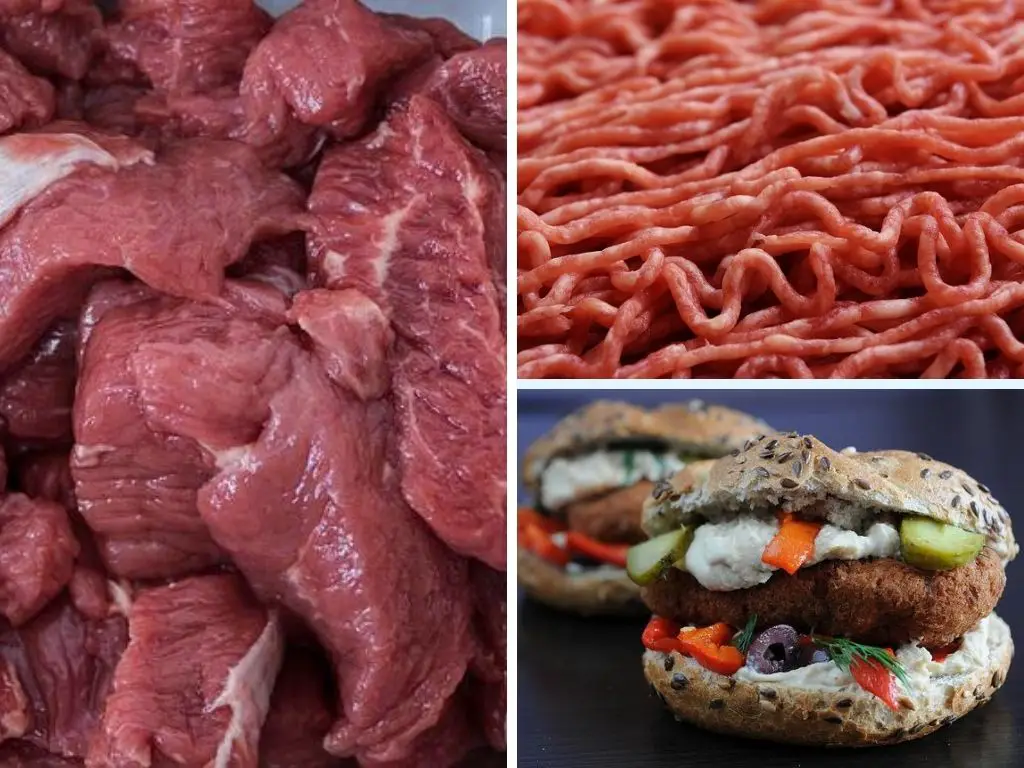In the guide below, we compare lab grown vs plant based vs real meat.
We explain what each one is, along with the key differences between them, and other relevant information.
Lab Grown vs Plant Based vs Real Meat: Main Differences, & Comparison
Lab Grown Meat
Lab grown meat is more similar to real meat than plant based meat
Both lab grown meat and real meat are products derived from animals, whereas plant based meat products typically aren’t
Lab grown meat specifically uses animal cells harvested from a live animal as the basis of the product
Plant Based Meat
Plant based meat generally uses plant based ingredients and plant based proteins
It generally does not involve the use of any animal cells or animal derived ingredients (although different plant based meat products might provide different guarantees on this)
Not being derived from animals differentiates plant based meat from real meat and lab grown meat
Plant based meat might be considered one of several potential meat substitutes and alternatives
Real Meat
Real meat is a traditional animal product
Unlike lab grown meat, it involves animal agriculture instead of cellular agriculture, and it also involves the slaughtering of animals for animal meat products (instead of extracting animal muscle or tissue samples like lab grown meat does)
Lab Grown vs Plant Based vs Real Meat: Other Key Features Of Each
Lab Grown Meat
– Also referred to as cultured meat
– As the name suggests, lab grown meat is grown in laboratory conditions via ‘cellular agriculture’
– Animal cells are harvested from a living animal by taking a muscle or tissue sample
– Animal cells are then multiplied in a lab, and undergo several steps in order to get to the finished cut of meat
Plant Based Meat
– Plant based meat generally refers to pre-made plant based meat products (e.g. plant based patties, sausages, ground meat, and so on) that are made to have a similar appearance, texture/consistency, and taste/flavor to real meat
– They are primarily made from plant based or plant derived ingredients instead of animal derived ingredients/products
– They generally contain a plant based protein (vegetables, grains, and legumes), a plant based oil (such as a vegetable oil like sunflower or canola oil, coconut oil, or cocoa butter), and then additives or other elements like binding agents
– Some examples of primary ingredients that might be used in plant based meat can include pea protein, potato protein, soy protein, rice protein, seitan (made from vital wheat gluten), and jackfruit. There are other primary ingredients used other than the ones listed here though
– They are generally made via a combination of traditional food manufacturing processes, and also unique processes specific to plant based meat products that aim to make the product a similar consistency/texture, flavor/taste, and appearance to real meat. escoffier.edu describes these processes further in their report
– The unique processes that plant based meat products go through to mimic real meat make them different to other meat alternatives and substitutes like standalone tofu or tempeh for example
Real Meat
– The traditional form of meat production
– Animals and livestock are generally reared on farms, ranches, and via other traditional animal agriculture operations
– Once animals and livestock are ready, they are sent to slaughter, the carcasses are cleaned and prepared, and butchers then prepare different cuts of meat for consumers
– Seafood and aquatic meat production (such as fish farming and aquaculture) might also be included in real meat production
Lab Grown vs Plant Based vs Real Meat: Potential Pros & Cons Of Each
Lab Grown Meat
Potential Pros & Cons Of Lab Grown Meat
Plant Based Meat
Potential Pros & Cons Of Plant Based Meat Products
Real Meat
Potential Positive Effects Of Traditional Agriculture On Different Aspects Of Society
Potential Negative Effects Of Traditional Agriculture On Animals, Wildlife & Biodiversity
Potential Negative Effects Of Traditional Agriculture On Humans, Health, Society & The Economy
Sources
1. Various ‘Better Meets Reality’ guides
2. https://www.escoffier.edu/blog/sustainability/how-is-plant-based-meat-made/
3. https://en.wikipedia.org/wiki/Cultured_meat
','' ); } ?>